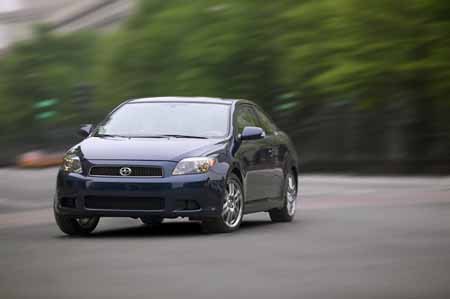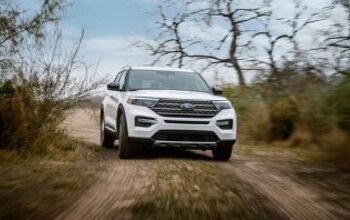Scion-tology
Is Scion a brand or corporate sleight-of-hand? The sales campaigns for the xA and xB display an ongoing and achingly self-conscious attempt to endow the Toyota subsidiary's products with its own distinct, youth-oriented identity. The company's demographics show that the marketing boys have, at the least, established a beachhead amongst their target market. In California, the xA and xB have demonstrated their appeal to young customers who fear that Mom's Camry is just too… well… Chevrolet.
On the other hand, Scion's products smack of parts bin engineering. Apart from their unconventional shapes and higher quality, the xA and xB are thoroughly banal commuter tins. In fact, consumers have seen their ilk before; a goodly portion of the pairings' greasy bits being cribbed directly from the prosaic Echo (a rare vehicular misfire for The House of Toyota). Scion's initial offerings may be cheerful, but they're also cheap.
Scion's latest salvo, the tC, aims markedly higher. With 160hp on tap (and an optional supercharger for the gluttonous), the tC distinguishes itself from its siblings by promising actual forward motion. The $16,500 coupe also provides refinement levels well above its class average. In the process, however, the tC steps ALL OVER Toyota's own aging Celica, a car selling for thousands more, despite offering substantially less refinement and bang-for-the-buck.
The problem is far more profound than simple fratricide. In the shallow end of the motoring pool, the axiom remains: small cars = small profits. Most small cars never realize black ink. Those that do don't until well into a model's lifecycle, after the cost of development and tooling have been amortized. By that point, whatever sliver of profit has been realized must be returned into R&D for the next generation. It's a vicious cycle with a low return rate.
The concept of fiscal viability inevitably comes to rest on the argument that small cars benefit a company's long-term prosperity. The crux of this theory– long employed to slake company bean counters– is that starter vehicles are the "gateway drug" to brand loyalty. The hypothesis lacks credible statistical proof, and defies common sense. Do corporate strategists seriously expect a Chevy Cobalt driver to drive a Cadillac in ten or twenty year's time?
Let's face it: the notion of cradle-to-grave brand loyalty is dead, a victim of an America increasingly addicted to the concept of ever-changing "choice." In this increasingly video-bite driven, high-definition society, with its endless stream of new products, a freshly-minted Scion owner is seriously unlikely to become the Lexus LS buyer of the future, no matter how high those J.D. Power rankings climb.
Lest we forget, despite their successes, this is the same Toyota that made several unsuccessful overtures into the full-size pickup arena (a state of affairs they have yet to rectify), along with a slew of oddball minivans (before they cracked the code). Obviously, for every lukewarm MR2 Spyder, Toyota has produced several homeruns (Camry, Highlander etc.) to take up the slack. Taken as an aggregate, they're on quite a roll. But they're certainly not infallible.
It's also instructive to note how other companies' 'mold-breaking' youth-targeted entries have fared. The irony is that most vehicles earmarked for modish young trendsetters usually find their audience among an altogether older demographic. How many fifty-year-olds do you see wheeling about in Chrysler PT Cruisers? Honda Elements? Quite a few. Perhaps they've been taken in by their 401k-sympathetic pricing, or maybe it's simply that older consumers can look past the cars' faddish designs and spot an inner utilitarian goodness… the ability to swallow mass quantities of potting soil while sipping gas, say.
Either way, once the Baby Boomers or Golden Oldies migrate to a car in sufficient numbers, even the most naive marketers know they can kiss a model's youth appeal hasta la bye-bye. What's more, older consumers are INFINITELY less likely to plump for options like the $299 illuminated cupholders (yes, really) that help Scion's quest for profitability. Worried yet? It's worth noting that Scion's youth-happy xB is already charting 51% of its owners at/above age 35. That percentage may well increase, as the xB's notoriety swings eastward from California into less style-conscious quarters.
There are other potential trouble spots for Scion-tists. Mitsubishi already learned the hard way that building a business on a young, fiscally irresponsible customer base is short term gain for long term pain. And again, there's that little matter of whether Toyota can grow the Scion sub-brand cost-effectively without cannibalizing sales from their own bigger-ticket offerings.
So, will Scion be successful? That depends on one's definition of the term. Scion's new products will realize new sales for Toyota, but it remains altogether suspect that these transactions will come from the demographic bogey Toyota is so desperate to court… and wasn't that the whole point of the exercise, anyway?
More by Chris Paukert
Latest Car Reviews
Read moreLatest Product Reviews
Read moreRecent Comments
- SCE to AUX Range only matters if you need more of it - just like towing capacity in trucks.I have a short-range EV and still manage to put 1000 miles/month on it, because the car is perfectly suited to my use case.There is no such thing as one-size-fits all with vehicles.
- Doug brockman There will be many many people living in apartments without dedicated charging facilities in future who will need personal vehicles to get to work and school and for whom mass transit will be an annoying inconvenience
- Jeff Self driving cars are not ready for prime time.
- Lichtronamo Watch as the non-us based automakers shift more production to Mexico in the future.
- 28-Cars-Later " Electrek recently dug around in Tesla’s online parts catalog and found that the windshield costs a whopping $1,900 to replace.To be fair, that’s around what a Mercedes S-Class or Rivian windshield costs, but the Tesla’s glass is unique because of its shape. It’s also worth noting that most insurance plans have glass replacement options that can make the repair a low- or zero-cost issue. "Now I understand why my insurance is so high despite no claims for years and about 7,500 annual miles between three cars.





































Comments
Join the conversation
In 2007 we can now say that yes Scion did hit their demographic targets and sell a lot of cars. Along the way they snagged me although I am outside their target marketing demographic for the XB.